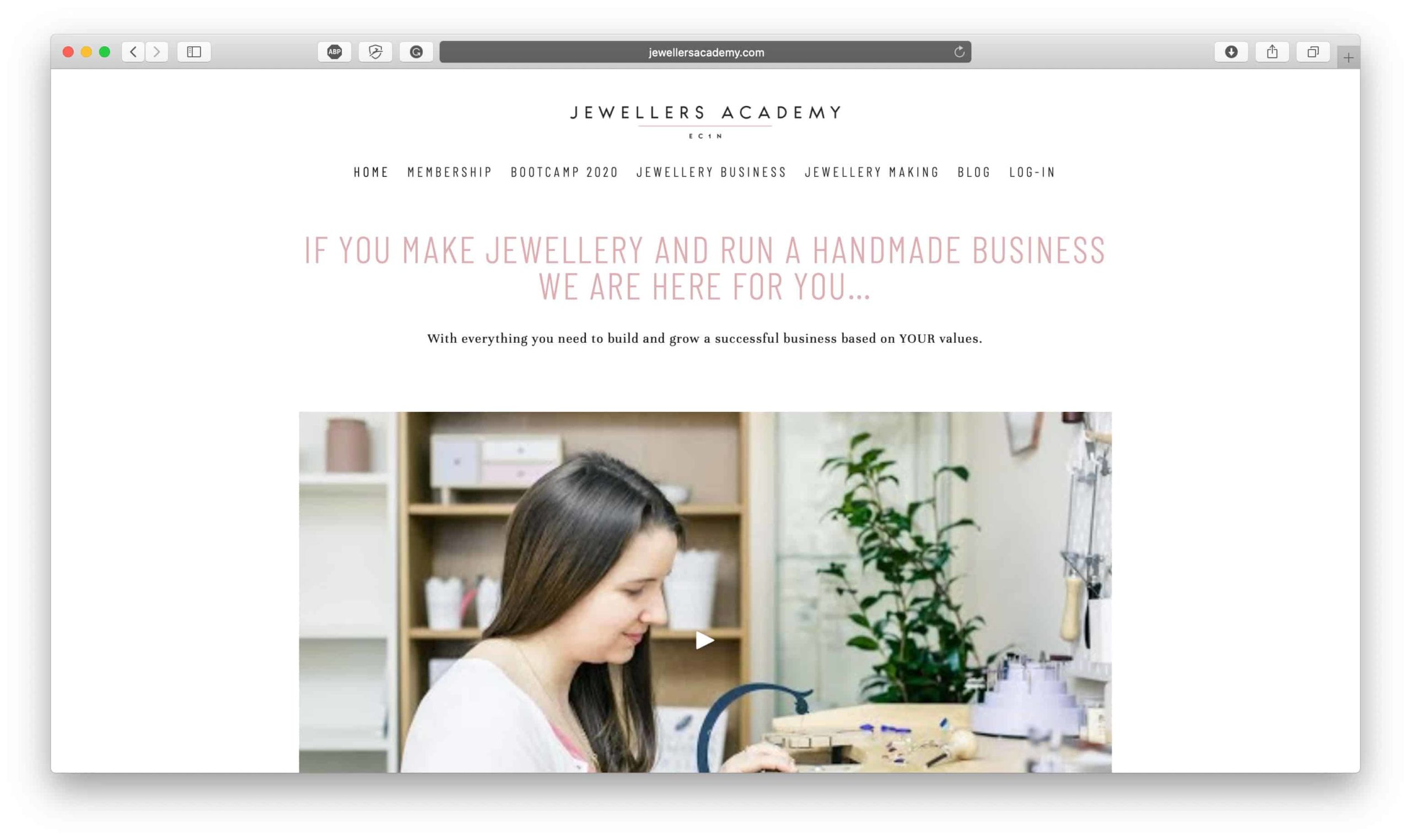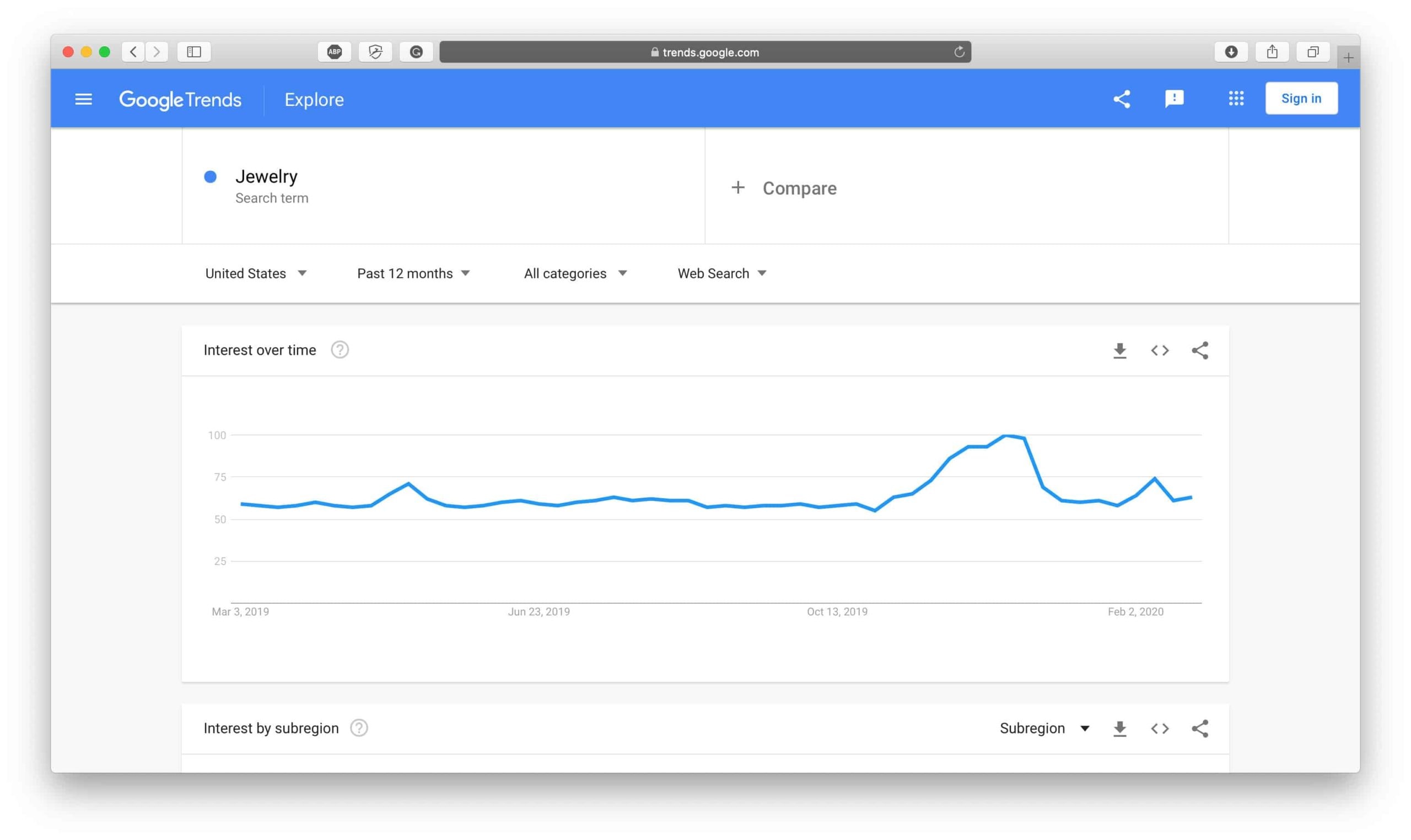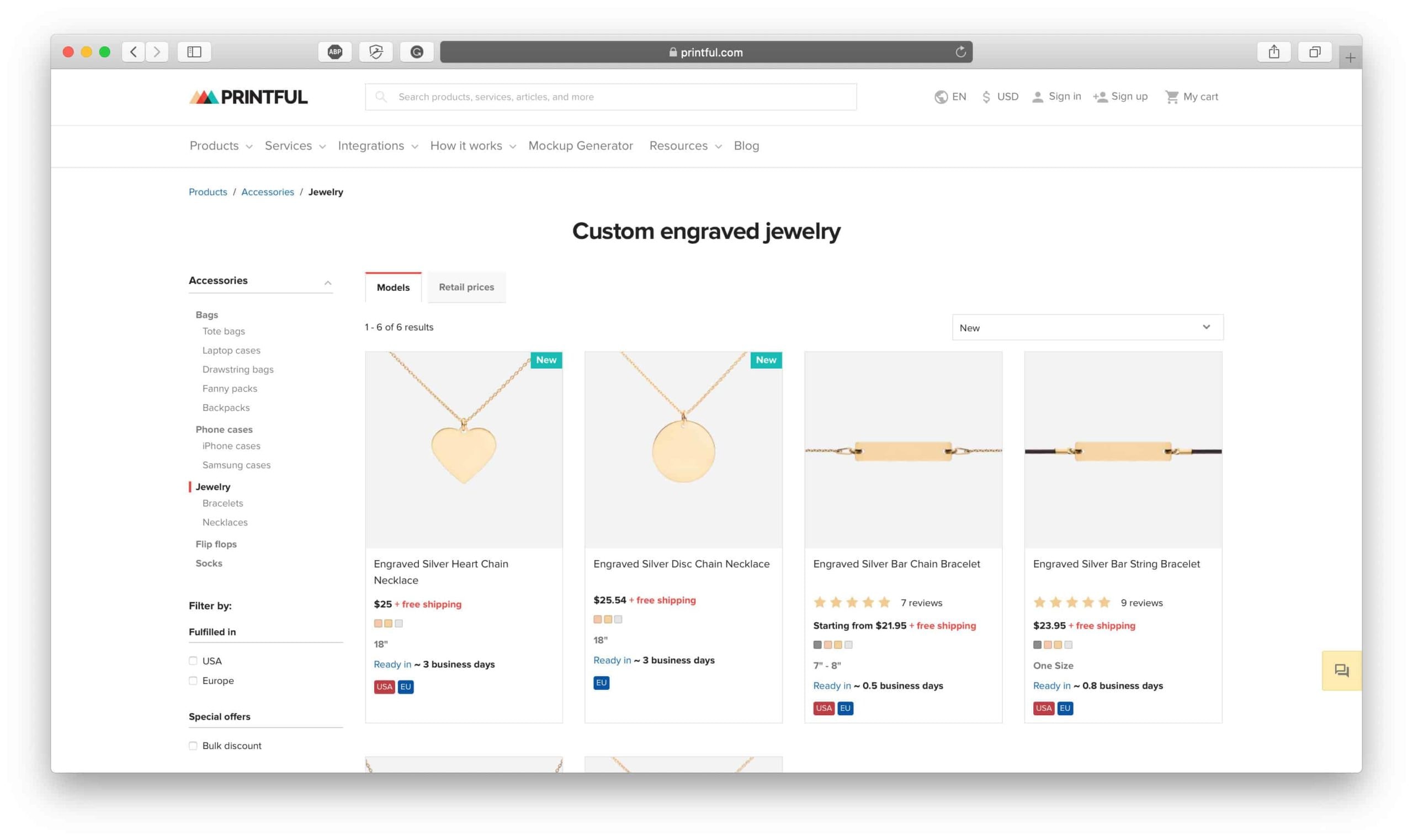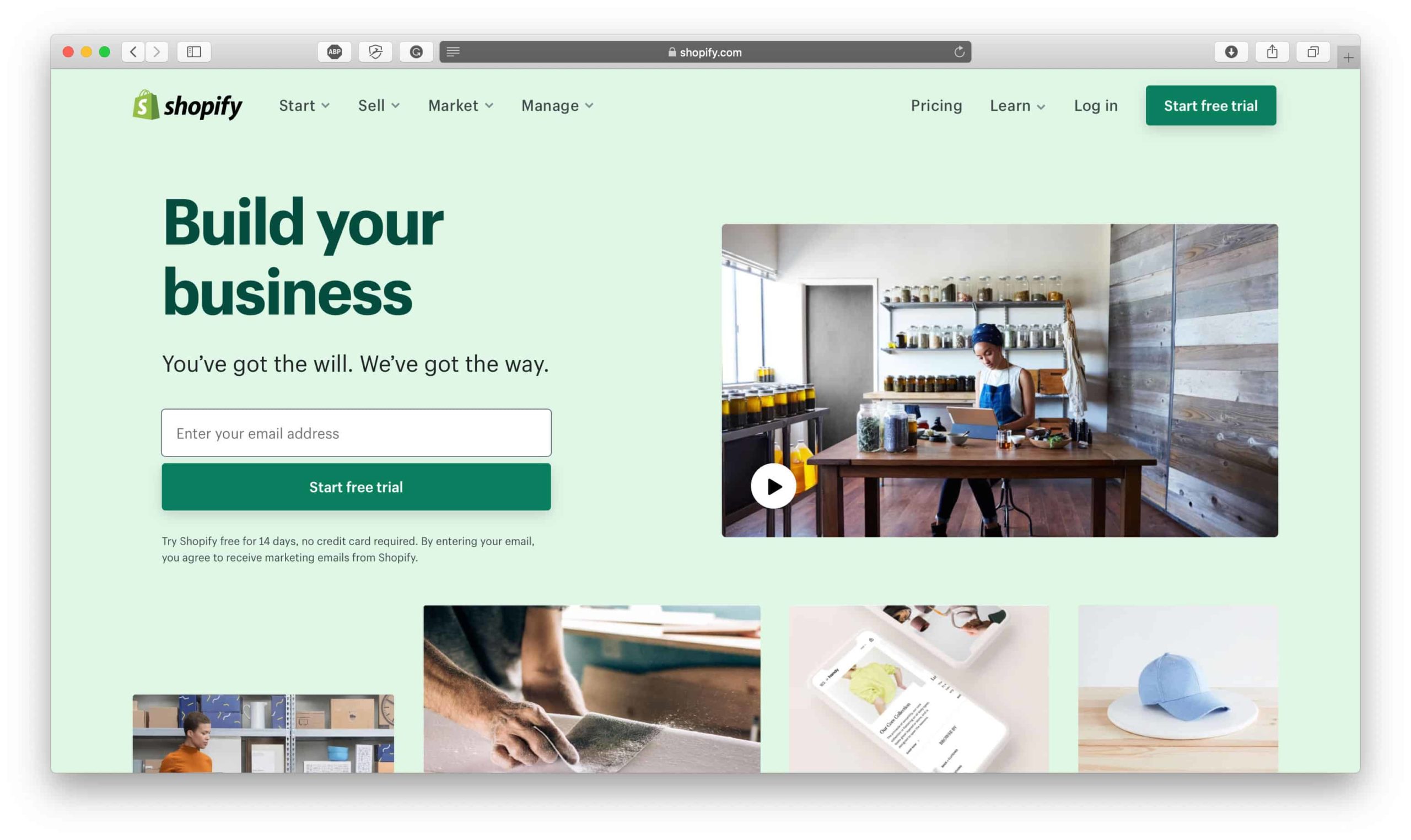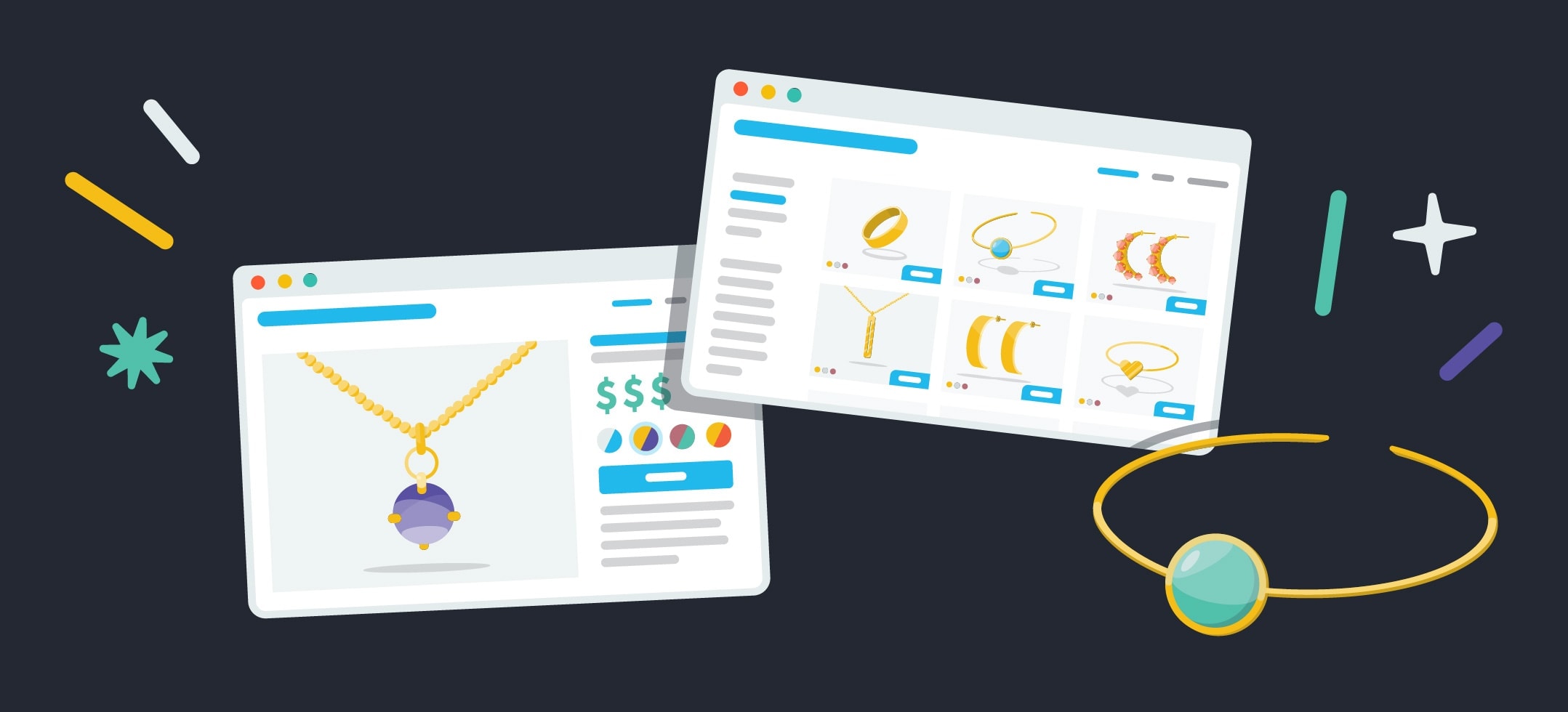
How to Sell Jewelry Online: Everything You Need to Know to Start a Jewelry Business
So, you’ve decided to set up an online store and your product of choice is jewelry. Maybe you enjoy making jewelry in your spare time and it’s attracting positive comments? Or perhaps you’re thinking about starting a low-investment dropshipping venture? Whatever your reasons, you want to make sure that your jewelry business a success.
But, nothing good ever came easy.
There’s a lot to consider. From marketing and maximizing product sales to sourcing or making your products and finding suppliers—there’s plenty to sink your teeth into.
What you might not know is that the world of online jewelry selling is a pretty crowded market space. The value of the jewelry market is estimated to rise worldwide from $278.58 billion in 2018 to a staggering $480.5 billion in 2025. The biggest market is in China, closely followed by the US, Japan, and India.
But don’t let that put you off—these stats tell us the demand for jewelry is enormous! So, if you want a slice of the pie, continue reading. We’ll take you through how to start up a jewelry business so you can start selling jewelry online. Hopefully, after reading our guide, you’ll be ready and raring to go!
Here’s what we’re going to cover:
- Market research
- Current trends
- Jewelry products and production
- Product photography for jewelry
- Setting up your online store
- Marketing your products
And more! But, enough of the introductions, let’s dive in.
How to Start a Jewelry Business
Do Your Research
Before you take a step further, you need to do your homework.
Don’t allow yourself to be impulsive about any decisions relating to your jewelry business. Instead, take the time to research your niche and your potential customer base before spending a single dollar on product development or store set up.
Products
First off, decide on the type of jewelry products you’re going to sell. Some stores focus on fine jewelry, others on costume jewelry or fashion jewelry, some on novelty pieces, and others mid-range statement accessories. That just names a few—but you get the point. There are lots of different jewelry niches to hone in on.
All of these options have advantages and disadvantages. For example, fine jewelry is made from semi-precious gems and metals so it’s more expensive to make compared to costume jewelry but the returns are usually much higher. Typically, fine jewelry also appeals to a specific audience, for example, someone sourcing an engagement ring or wedding ring or special gifts.
In contrast to this, fashion jewelry is normally cheaper to source and less expensive to make. It is, therefore, more affordable to sell and mass-produce. On the whole, you’ll usually use inexpensive materials like beads, metals, plastics, and synthetic gems to make the jewelry products. This type of jewelry may attract fashion-conscious customers with a smaller budget who are happy with jewelry products that may not last a lifetime.
Whereas mid-range products cost less than fine jewelry, but more than fashion pieces. These items may be statement accessories, such as unique necklaces or earrings. Typically, they’re made from materials like acrylics, woods, metals, and so on. Sometimes, these products are limited edition, one of a kind, or replica imitations of fine jewelry.
Customers
Decide who you want your shoppers to be and then design the kind of products they’ll buy. A great starting point is putting your potential customers into categories like:
- Brides to be
- Fashionistas
- Ethical shoppers
- The classic jewelry lover
And so on.
Once you know who your target customers are, you can then find pieces that match their tastes, values, interests, etc.
Training
Do you have jewelry product ideas figured out and your customer base decided on but you don’t have the skills to actually make your jewelry products? It’s true that you don’t necessarily need jewelry-making skills if you’re outsourcing product creation but if you’ve decided that making and selling jewelry online is the right career path for you, it’s sensible to get some training!
Also, even if you are outsourcing the production of your jewelry products to manufacturers, it’s wise to familiarize yourself with frequently-used terminology and production methods. That way, when you speak to suppliers you can communicate what you’re looking for more effectively and you’ll be more likely to successfully negotiate with them when you comprehend the industry.
Before committing to a jewelry-making course, check out the course reviews and credentials. There are tons of online learning materials out there so, if you want, you can study in the comfort of your own surroundings—win-win!
Here are a few ideas—in no particular order—of where you might want to start your jewelry education:
- The Jewelers Academy
- The American School of Jewelry
- At the Bench
- BluPrint
- YouTube—there are literally hundreds of tutorials and full-on courses here
It’s also worth checking locally to see whether there are any workshops, seminars, or markets you can attend to pick up a few tips. You may even find that your local schools, colleges, universities, or community centers run craft-related courses or also look for local craft-making groups you can join. Any of these communities would be the ideal place to learn new ideas and enhance your skills.
Explore Current Trends
Exploring current trends will give you a better sense of what’s selling right now and, more importantly, what isn’t. There’s no point investing tons of money into jewelry that isn’t on-trend or selling well.
One of the easiest ways to keep your finger on the pulse is by reading specialized blogs and magazines. These resources will help keep you in-the-loop with what’s in and what’s not.
Also, try looking at what celebrities, TV stars, actors, and musicians are wearing. After all, we all know the impact a celebrity can have when it comes to marketing and selling fashion and jewelry.
Online Research
One easy way to monitor past, present, and future trends is a tool like Google Trends.
Just type in a search term like “Jewelry” or “Earrings” and you’ll see the popularity of the search query over time. You can also filter your search by location or time period to get even more specific. For instance, you can narrow-down trends from as recently as the past 4 hours, day, month, or as long as 12 months, 30 days, 90 days, 5 years, and from 2004 to present. It’s an invaluable tool.
Carve Out Your Own Niche
Maybe you’ve done all the above but you’ve spotted a gap in the market? Or you have a unique idea that you’re convinced is going to sell. You could be creating your own niche.
Having a store that stands out because customers can’t buy jewelry products like yours anywhere else can be really lucrative. It’ll certainly provide you with a unique selling point that you can showcase in your online ads and marketing materials.
If you choose to sell products that really reflect your brand and your niche (which we certainly urge you to do) then you also have to tell your story. This includes outlining your vision on your “About Us” store page. Doing this will help carve out your niche and attract your target customers.
For example, if you plan on selling fairtrade jewelry products to a niche market of consumers interested in purchasing fairtrade jewelry, tell visitors why you were inspired to do pursue this route, such as what personal experience touched your heart or why fairtrade products are important to you, and so on.
Stay Inspired
Don’t forget to conduct product research once you’ve decided what kind of jewelry products you’re going to sell online. You need to stay inspired. Use tools like Pinterest and Instagram to fuel your fresh designs. Keep idea boards and pin jewelry pieces that inspire you—you might be surprised where your inspiration comes from!
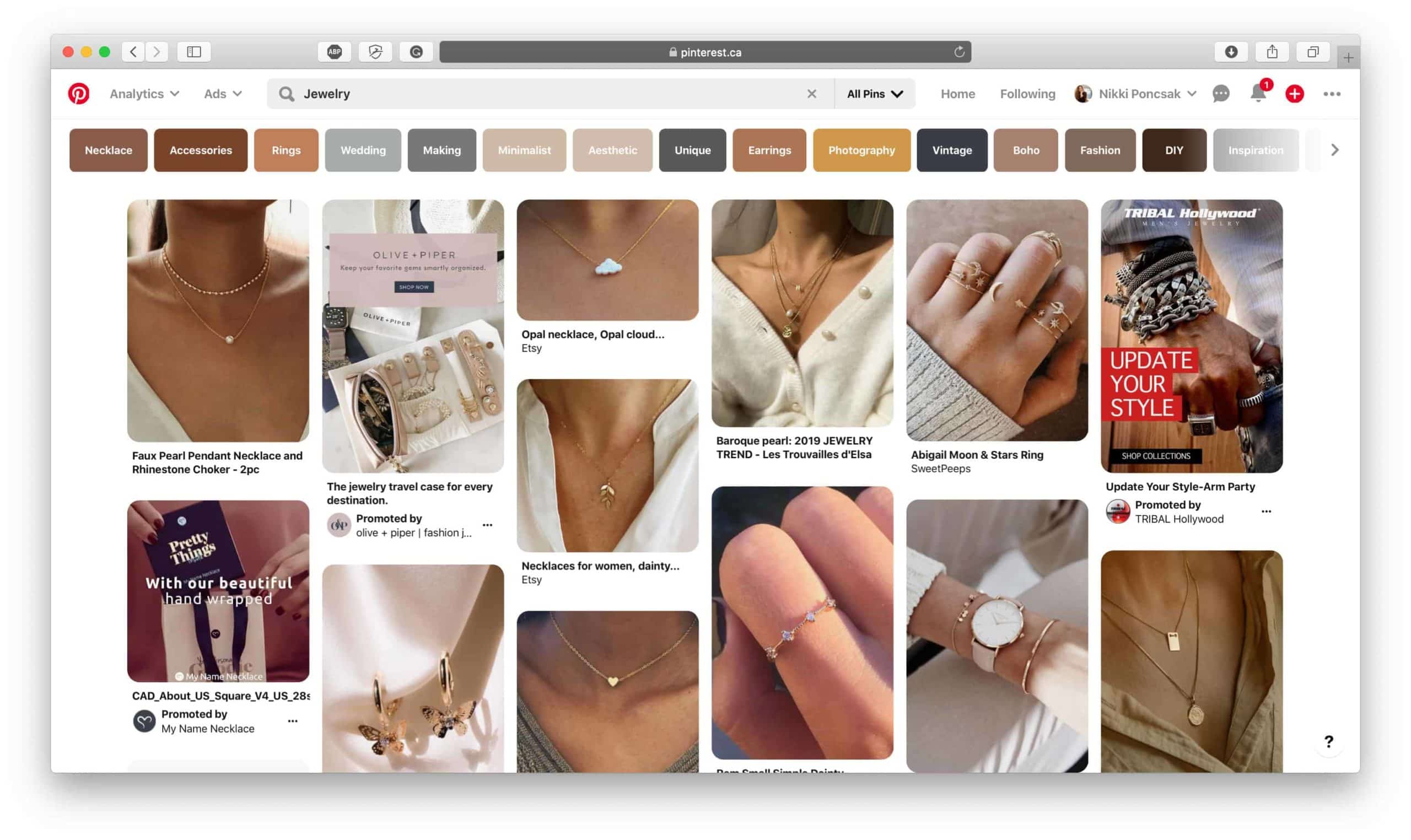
Your Jewelry Products and Production
Either you’re going to design and make your own jewelry, collaborate with a designer or manufacturer to produce your products, or source jewelry products from a wholesaler or dropshipper.
Have the Right Equipment
If you’re making your own jewelry, you’ll need to use the right equipment. Depending on your skill levels and budget, you’ll need:
- Pencils, paper, jewelry design templates, bead trays, etc.
- Software for designing jewelry like Photoshop, Pixlr, Illustrator, RhinoGold, Zbrush & Sculptris and Matrix
You’re also going to need tools and supplies, for example:
- Chains
- Beads and stones (gemstones, pearls, synthetic stones, etc.)
- Wire
- Earring studs and backs
- Clasps
- Metals
Or whatever else is necessary to bring your vision to life.
The web is full of tools and suppliers and it can feel somewhat daunting to wade through them all. So, below is a list of the more popular suppliers for sourcing jewelry-making materials. But it’s still important that you do your own research and costings before ordering. Take a look at customer reviews and communicate with the supplier to get a feel for their quality and reliability before committing to working with them.
Popular suppliers include:
- The Welman Group
- Alibaba
- Wholesale Jewelry Supply Co.
- Beads US
- AliExpress
- Fire Mountain Gems
- Cheap Wholesale Jewelry
Many of these sites also sell ready-made items, too, so if you’re considering the dropshipping approach, sites like AliExpress are worth exploring.
Jewelry Business Manufacturing & Materials
Once you know the kind of jewelry you’re going to sell and whether it needs any input from you in terms of design, etc., start looking at product development and manufacturing.
The Production of Fashion & Costume Jewelry
Making or outsourcing the creation of fashion and/or costume jewelry is more straightforward than, say, commissioning one-of-a-kind, high-end pieces.
You’ll be able to buy all the parts you need to construct your items in bulk such as wire, beads, glue, and so on. You can also work with a jewelry manufacturer to create your products for you.
If you have designs rendered from the jewelry templates and software that we mentioned above, you can use these blueprints to mass-produce items. If you’re employing anyone to help you, they can use these, too.
The Production of Fine Jewelry or One-of-a-Kind Pieces
If you want to go down the avenue of creating your own pieces of fine jewelry, check out a few webinars and online courses before you get going. The knowledge gained from these resources could potentially save you from making expensive mistakes.
Creating bespoke jewelry is detailed and challenging work. You might need specialist equipment or, if you’re outsourcing product creation, you need to ensure that the manufacturers are using high-quality materials and possess the requisite skills before hiring them as your supplier.
Of course, there are different ways of making fine jewelry or one-of-a-kind items so do your research to get a feel for which methods and materials will appeal to your target audience the most.
Here’s a list of some of the methods and skills involved:
- 3D printing
- Casting
- Gemstone setting
- Goldsmithing and/or silversmithing
- Laser cutting
- Leather crafting
This is a very brief list, but hopefully, it has provided a splash of inspiration for what’s possible.
Outsourcing
If you don’t want to make jewelry products yourself and you’re planning on selling substantial quantities of jewelry, having a third-party make your jewelry is usually the most cost- and time-effective route. This is especially true if you’re running your jewelry business as a side hustle to your day job or other businesses.
You can either choose to either outsource your products from overseas or domestically. That’s up to you and your budget and, sometimes, your brand’s ethics.
For example, if one of your unique selling points is that your pieces are locally sourced and produced, then you’ll want to outsource the production of your products to domestic manufacturers. If, however, you’re running your jewelry business on a really tight budget, then dropshipping products from suppliers found on marketplaces like AliExpress might be the best course of action. These sorts of choices all come down to the needs and wants of your brand because there are advantages and disadvantages to both.
Sourcing Jewelry Products Locally:
- Usually more expensive
- Typically boast shorter shipping times
- It’s easier to communicate with the suppliers (there’s likely no language barriers or time zone issues)
- It’s easier to verify their credentials
- You can add “locally sourced and made” as one of your unique selling points
Sourcing Jewelry Products from Overseas:
- You can typically source products for cheaper
- Comparatively longer shipping times
- It can be harder to communicate and verify suppliers’ credentials
Dropshipping & Shipping
Deciding how your customers receive your jewelry is one of the most important decisions you’ll make when setting up your jewelry business.
If you’re dealing with bulk orders for mass-market sales, you might prefer dropshipping as a business model method. If, however, you’re focusing on creating bespoke pieces or you’re warehousing your own products, you’ll probably prefer traditional shipping options.
In light of this, we’ve provided an overview of both options below so you can decide which is the best option for you.
Dropshipping
If you don’t wish to make your own pieces or want a reasonably hands-off jewelry business model then dropshipping is the way to go.
If you don’t know what this is, let us enlighten you. Dropshipping is a means of managing your supply (jewelry) without actually having to manufacture it or store it where you are (home, work, a warehouse, etc.).
You source the products you wish to sell via websites and apps like Spocket, Oberlo, AliExpress, etc. and upload those products to your online storefront. When your customers buy from you, your supplier then ships these products directly to your shoppers without you ever handling the items at all.
The reason we mention dropshipping at all is that it’s a different way of selling from the usual sales model; you don’t own your stock and you don’t hold inventory. Instead, the third-party supplier does and you just buy it as and when a customer buys it from your store. Your third-party supplier then fulfills your order on your behalf. Simple!
Still, confused? Here’s a step-by-step walkthrough:
- Step 1: Your customer buys a necklace and matching earrings from your online store
- Step 2: You alert the third-party supplier of the order (this is usually done automatically depending on the supplier you’re using. Most of them have apps that integrate with popular ecommerce platforms like Shopify)
- Step 3: Your supplier prepares the order for despatch
- Step 4: Your supplier ships the order to your customer’s address, and the customer believes that the order came directly from you
That’s it!
Other popular dropshipping apps that offer jewelry include Printful, Modalyst, and Printify so if you’re considering this business model, be sure to check them out!
So what, in a nutshell, are the advantages and disadvantages of dropshipping?
Dropshipping Pros:
- A third party does the majority of the work for you—packaging, warehousing, shipping, etc.
- No storage issues
- It’s typically less expensive than making your own products
Dropshipping Cons:
- You can’t quality-check your products and packages before they go out to your customers
- It can be hard to manage customer service if you can’t understand why people are returning them or if there are shipping and delivery issues
- You have less control over the entire process
- You have less input in the branding (usually you can’t put your logo on the products or shipping boxes, etc.)
Traditional Ecommerce Shipping
If you’ve decided to ship your own products, here are a few things you’ll need to consider from the get-go:
Packaging: If you’re sending small, fragile, or valuable items they can often breakable, prone to damage, and might carry the risk of being lost or stolen. With these factors in mind, be sure to choose your packaging wisely. Alternatively, you may want to consider creating your own branded packaging with a company like Packlane (Packlane Review) if you have a slightly bigger marketing budget.
Costs: Once you know the kind of packaging you’re going to use, you can factor that into your costs. It’s also worth noting that most shipping carriers will calculate the price of sending something by its size, weight, and where it’s sent to and from. USPS, UPS, FedEx, and Canada Post all have shipping calculators so you can calculate your costs before leaping in. Find links to those shipping calculators here.
If you also want shoppers to be able to track their parcels, this may cost more. An additional expense to consider is insurance against loss and theft—this is especially important if you’re shipping high-value jewelry pieces like engagement rings.
If you’re using Shopify to host and manage your online store, you can pay for your shipping through them (if you’re in the US or Canada). They offer pre-negotiated rates, which you can cash in on. Shopify even integrates in real-time with USPS and other carriers, so that customers can see and choose from a variety of shipping prices—how neat is that?!
Shipping Rates: Are you expecting your customers to pay for shipping, or will you? Many customers today expect free shipping. If your budget doesn’t allow for that, consider how you could adjust the price tag of your jewelry so that it covers the cost of shipping.
You could also consider implementing a flat-rate shipping fee or offering free shipping only when someone spends over a certain amount. Some online retailers will charge real-time carrier rates. Again, this all comes down to your budget, brand, and the preferences of your target audience.
Margins: If you want to make a success out of your jewelry business, you’re going to have to ensure that your costs don’t rocket out of control due to expensive shipping costs. Remember, fees can add up. If you’re going into this as a new business owner, try using the example approach below to give you a sense of how much you should charge for your products and shipping:
- Product cost: $25
- Packaging cost: $1.00
- Shipping costs: $4.50
- Customs/Duties (if you cover them): $5.00
- Credit card fee: $2.50
- A markup of 50%: $19 (the product cost + all of the other costs, divided by 2)
- Total price: $57 (the product cost + all of the other costs + the markup)
Get it?
Product Photography for Your Jewelry Business
Taking photos of your products has to be taken seriously. Often, it’s the first thing customers look at and can make the difference between a sale or someone leaving your store altogether.
So, presenting your products in their most attractive light is essential. But don’t worry, it doesn’t have to be complicated.
Think about how we live in this photo and video dominant age. Facebook, Instagram, Pinterest, and even Twitter are all heavily littered with photography.
Research by MDG Advertising found that:
- Images on Facebook receive 352% more engagement than links
- 67% of consumers say that when they’re choosing a product, the quality of the image is important
- 63% of consumers say the quality of a product image is more important than its value
- Adding an image to a product can improve its recall by 65%
So with these stats in mind, let’s take a look at some of the ways you can guarantee top-notch product photos.
Planning Your Photography
It can be challenging to capture high-quality images of jewelry—especially if the pieces are small and have lots of detail. This sometimes results in the light reflecting at odd angles and, in some cases, can appear very flat when photographed.
Yes, you can take snaps of your product with your iOS device or DSLR. Still, it’s really worth considering investing in a professional photographer whose portfolio includes photographing small objects and has experience in ecommerce product photos or fashion and retail. But, if your budget doesn’t stretch to that right now, don’t panic. This is something you might aspire to do in the future.
You should also think about using a model to wear your items. Customers like to see products on someone because it’s much easier to imagine yourself buying something if you can see how it looks on someone rather than it just laying flat on a surface.
If you’ve decided to go ahead and take your own product photos, continue reading this section for a few tips and tricks.
How to Take Jewelry Product Photos: The Basics
First off, ensure you have enough light. If you’re inside, shoot near a window. Choosing the right environment for your photos is really important.
For example, say you’re showcasing a necklace and earrings combo. Laying them flat on a white or plain, light-colored backdrop will best highlight their details and colors. Look how often successful retail stores use white to showcase their items—they do this because it works. There’s no need to reinvent the wheel!
Taking that same necklace and earrings and putting them on a model gives customers an idea of their size and scale—not to mention how they look when worn with particular outfits.
You also could photograph your model outside if the conditions are suitable. Or just snap a waist-up, portrait-style shot of your model against a soft-looking fabric to allow for a gentle texture and a sense of light. It goes without saying, each piece and model you photograph will have a different look that you’ll want to showcase in their best light.
If you have a DSLR camera, ensure that you understand its capabilities and which settings you’re going to need for photographing your products. If you’re using a smartphone/iOS device, don’t use any filters or digital zoom because it can decrease the quality of your photos. Instead, take your photos and then adjust the size/color during the editing stage.
Ultimately, it’s down to you how you take your photos, but again, do your research before snapping away. There are plenty of useful product photography tutorials you can read before starting out.
The Photo Editing Stage
Before uploading your photos onto your store, you’re going to have to edit them so they’re sufficiently uniform, the right size, the light looks good, and so on. It’s important not to skip this stage.
Photo editing software such as Photoshop is a great start. If you’ve used it before, that’s great, but are you aware of all of Photoshop’s features? We have a useful refresher on product photography essentials for jewelry that will walk you through the best ways to use Photoshop to maximize the quality of your photography so that your photos really stand out from the crowd.
Common Jewelry Photography Errors
Here are a few well-known mistakes people make when taking photos of jewelry. If you want to avoid the same errors, keep these at the forefront of your mind as you shoot your products:
- Reflection: We’ve already mentioned that jewelry attracts a lot of weird reflections. Add to that the light that’s coming into the room (that you need) and you could end up with a photo that looks faulty or smudged. So, be sure to double-check for that as you take your images.
- Out of Focus & Poor Focus: This is likely to occur if you’re using a smartphone or DSLR without a tripod. If you take a photo of your jewelry on a low aperture, it’ll look poorly focussed. You want a picture of high aperture and full focus.
- Fussy Background: A fussy or highly texturized backdrop will detract from the item you’re photographing. Have a solid white or light-colored background for best results.
- Limited Imagery: Don’t limit yourself to just one photo per item. Customers click on something they like because they want to see more of it before they buy it. So, our best advice is to upload several pictures of the product displaying different angles (five or more product photos is generally the industry standard) as this helps the customer get a feel for whether the piece is for them.
- Inconsistency: Shoot all your images in the same light. You don’t want some pictures with darker backgrounds than others—this often occurs because you’ve lost the light. If that happens, don’t worry; just pick things back up again tomorrow. This may take you longer, but trust us, consistency is critical for creating a professional and robust brand.
Setting Up Your Online Jewelry Business Store
Yay! You’re almost ready to set up your online jewelry store!
If you’ve already done your research and know which ecommerce platform you want to use, that’s great. If not, have a look around the web and weigh your options.
There are plenty of providers out there and while this article isn’t about which ones are the best to go for, a quick Google search can tell you these are the most popular options:
- Shopify (see our Shopify Review here)
- BigCommerce
- Squarespace
Do your own research first and find the right ecommerce platform for you and your products. Most of these platforms come with free trials so be sure to take advantage of those before committing to one.
Things to Look Out For
We can’t tell you which ecommerce platform to choose but whatever you opt for, ensure that it has plenty of resources to help you launch, manage, and scale your jewelry business.
Your chosen ecommerce builder must also support you, whether that be via live web chat, phone, or through an in-depth knowledge base. You don’t want to be left high-and-dry when you have a question that needs answering. Also, check if the ecommerce provider will walk you through setting up your storefront step-by-step. It just makes life easier and, in some cases, it can help you get up and running within hours!
Not only that, double-check their website design templates for quality and whether the layouts are suitable for you to upload your product photography and descriptions into.
Also, check the analytics and reporting tools you’ll get for your money. You want to get better insights into who your customers are, where they come from, and why they gravitate towards your brand. This is why high-quality analytics and reporting are a must-have. With this data, you can then tailor your marketing strategies to better engage with your target demographic.
Be sure that your ecommerce platform also either provides you with an app store brimming with native apps for you to download and use or that you have the option of adding your own. Popular integrations include apps that manage your stock, inventory, and product returns. These are just a few examples, but there’s a plugin for pretty much everything—so make sure you’re not missing out!
Product Descriptions for Your Jewelry Business
Once you’ve chosen an ecommerce platform and set up your store, you’ll eventually have to write your product descriptions. When that happens, ensure that you do the following:
- Keep specifications consistent
- Highlight all the different sizes and variations available (especially if you’re selling jewelry like rings or different metals like gold, silver, and rose gold)
- Use a tone of voice reflects your brand
- Accurately describe what the product is
- Include care instructions for the product
Be sure to be clear about the materials your jewelry is made from such as which metals, stones, and so on, so your customers know exactly what they’re purchasing. If you have any specific unique selling points that you want to highlight, such as your products being fairtrade, your copy should also include the relevant information.
The same goes for if you’re making your products yourself—make sure your product descriptions tell a story and use this story to entice customers into your world. It’s a great way to sell.
Your product description is how you inform customers about the product they’re looking at and it’s also part of how you encourage them to buy it. When you’re writing, focus on who your target audience is: What do you think they’ll want to know? Write with that person in mind.
Make sure your product description provides customers with reasons to buy—this means describing the benefits of the jewelry. For example, “this necklace will really enhance any evening dress,” and so on. Your customers have imagination, so use that to your advantage.
Marketing Your Jewelry Business
You can’t market your products creatively unless you understand how jewelry sells and why people buy it. If you’ve done your research from the start, you may already have this knowledge at your fingertips. Take a leaf out of the fashion industry’s book and look at successful retail outlets and how they market their products.
Whatever your budget, you’re going to need a marketing plan.
Your Jewelry Business Marketing Plan
This should be broken down into two main strands: Online and offline marketing. Both need to reflect your brand and raise awareness of it. You want people to get to know your products, where they can buy them, and then return to your site again and again.
For them to do that, you’ll need tools to capture customer information so you can market more effectively via social media, email, and, even in-person.
Importantly, you’ll also need to optimize your store for SEO. This is the first step you need to take to ensure you stand above your competitors in Google’s rankings. Your chosen ecommerce platform should be able to help you here or at least integrate with apps that can like Google Analytics, Shopify’s analytics, Yoast SEO, and BigCommerce’s Insights—so be sure to look into these plugins.
It’s also worth listing out all of the information you believe your jewelry business needs for it to grow. These metrics are also known as key performance indicators (KPIs). This list should include KPIs that will provide a better understanding of who your prospective customers are and how they shop. Once you know the sort of KPIs you want to acquire, you can start capturing, storing, and analyzing them with the help of the analytics tools we mentioned above.
Example KPIs include:
- The number of new visitors to your store
- The number of returning visitors to your store
- The number of visitors who buy
- Who clicks on links inside your email newsletters
- The number of page visits to your blog
- The number of unsubscribe rates
- The number of email bounce rates
- The length of time visitors stay on your site and specific pages
You get the idea.
Online Marketing
If you’re unsure of how to kickstart the online marketing process for your new jewelry business, here are some ideas:
- If you can, try getting online influencers to wear your jewelry pieces and post about them on social media. Be sure to target people who already have a following who are very similar to your target audience
- Ensure that your products are well photographed and share those photos on your own social media platforms
- Consider investing in Google ads, Facebook ads, and Instagram ads and research how to launch these campaigns successfully
- Ensure that your chose ecommerce platform can help you build email lists so you can send automated messages to new subscribers and past customers
- Write a blog on your site that includes photos of your products—this is great for SEO!
- Don’t restrict yourself to one sales channel—try Etsy, Amazon, eBay, etc.
- Capitalize on calendar events like Valentine’s Day, Christmas, graduation season, etc.
- Keep up with current events that you can hook publicity to. For example, the Oscars. Spot a celebrity wearing a fantastic necklace? Find a similar product in your store and push it to your customers. Or, has someone really famous just got married/engaged? Check out the rings, see what you have that closely resembles it and push it to your customers as a “wear one just like it” campaign
- Market yourself as a jewelry expert. For example, if you’re selling high-end or one-of-a-kind items, you can pitch yourself to publications like Vogue or Tatler. These attract an audience of people looking for products to buy. Also, try guest-blogging on jewelry and fashion sites and promote yourself that way
- Once you have customers, ask them to be ambassadors and to review your products. Make your customers part of your marketing mix
Face-to-Face Marketing
Why restrict yourself to only selling online? People still love a human touch. If you’re selling one-off pieces or fine jewelry, see if you can get them placed in a few independent stores where you live or nearby. Yes, you’ll have to share profits, but it’s another way of getting your name out there. Have some branded business cards made up and leave them in the store for customers to pick up—you never know how many orders you might get.
Other ideas include:
- Politely ask friends and family to wear your jewelry and make it a talking point to get word-of-mouth marketing. Ask those same friends and family to take selfies of themselves wearing it and post them on Facebook, Instagram, and Snapchat
- Wear your own jewelry and tell anyone who asks about it where they can buy it from
- Set up stalls at popups, craft fairs, and Christmas markets
Ready to Start Selling Jewelry Online?
Now you’ve got all the essential information you need to set up your online jewelry store, it’s time to hit the ground running.
Remember to conduct in-depth market research and look into current trends before you do anything else. Then carefully select your products and shoot beautiful product photos. Then, and only then, will you be ready to create, launch, and market your online store.
Let us know how your online jewelry business goes and send us updates. Good luck!

